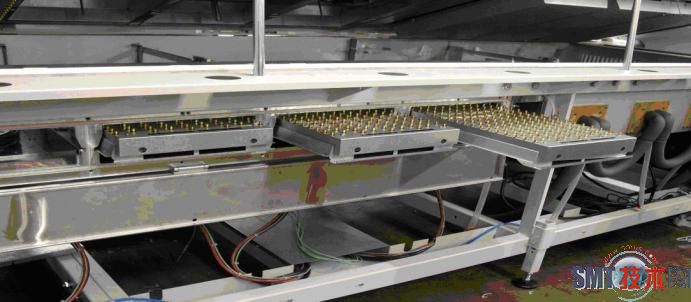l Lead-free high temperature requirements for equipment materials
Lead-free production requires equipment to withstand higher temperatures than leaded production. If there is a problem with the equipment material, a series of problems such as furnace cavity warpage, track deformation, and poor sealing performance will occur, which will eventually seriously affect production. Therefore, the track used in the lead-free reflow oven should be hardened and other special treatments, and the sheet metal joints should be X-ray scanned to confirm that there are no cracks and bubbles to avoid damage and leakage after long-term use.
l Effectively prevent furnace cavity warpage and rail deformation
The cavity of the lead-free reflow soldering furnace should be made of a whole piece of sheet metal. If the cavity is spliced with small pieces of sheet metal, it is prone to warpage in the lead-free high temperature.
It is very necessary to test the parallelism of rails under high temperature and low temperature. If the track is deformed at high temperature due to the material and design, the occurrence of jamming and board drop will be unavoidable.
l Avoid disturbing solder joints
The previous leaded Sn63Pb37 solder is a eutectic alloy, and its melting point and freezing point temperature are the same, both at 183°C. The lead-free solder joint of SnAgCu is not a eutectic alloy. Its melting point ranges from 217°C to 221°C. The temperature is lower than 217°C for solid state, and the temperature is higher than 221°C for liquid state. When the temperature is between 217°C to 221°C The alloy exhibits an unstable state. When the solder joint is in this state, the mechanical vibration of the equipment can easily change the solder joint shape and cause disturbance of the solder joint. This is an unacceptable defect in the IPC-A-610D standard of acceptable conditions for electronic products. Therefore, the transmission system of lead-free reflow soldering equipment should have a good vibration-free structure design to avoid disturbing the solder joints.
Requirements for reducing operating costs:
l The tightness of the oven cavity
The warpage of the furnace cavity and the leakage of the equipment will directly cause the linear increase in the amount of nitrogen used for electricity. Therefore, the sealing of the equipment is very important to the control of production costs. Practice has proved that a small leak, even a leak hole the size of a screw hole, may increase the nitrogen consumption from 15 cubic meters per hour to 40 cubic meters per hour.
l Thermal insulation performance of equipment
Touch the surface of the reflow oven (the position corresponding to the reflow zone) should not feel hot (the surface temperature should be below 60 degrees). If you feel hot, it means that the thermal insulation performance of the reflow oven is poor, and a large amount of electrical energy is converted into heat and is lost, causing unnecessary energy waste. If in summer, the heat energy lost in the workshop will cause the temperature of the workshop to rise, and we have to use the air-conditioning device to discharge the heat energy to the outdoors, which directly leads to double energy waste.
l Exhaust air
If the equipment does not have a good flux management system, and the discharge of the flux is done by exhaust air, then the equipment will also discharge heat and nitrogen while drawing out the flux residue, which directly causes an increase in energy consumption.
l Maintenance cost
The reflow oven has extremely high production efficiency in mass continuous production, and can produce hundreds of mobile phone circuit boards per hour. If the furnace has a short maintenance interval, a large maintenance workload, and a long maintenance time, it will inevitably occupy more Production time, resulting in a waste of production efficiency.
In order to reduce maintenance costs, lead-free reflow soldering equipment should be modularized as much as possible to provide convenience for equipment maintenance and repair (Figure 8).
Post time: Aug-13-2020

